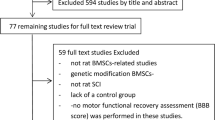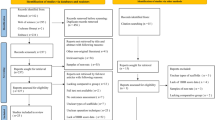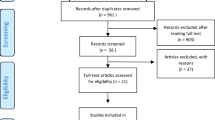Abstract
Purpose
In this systematic review and meta-analysis, the use of alginate for the repair of the damaged spinal cord was investigated.
Methods
After an extensive search of databases including MEDLINE, SCOPUS, EMBASE and Web of Science, an initial screening was performed based on inclusion and exclusion criteria. The full text of related articles was reviewed and data mining was performed. Data were analyzed by calculating the mean of ratios between treated and untreated groups using STATA software. Subgroup analysis was also performed due to heterogeneity. Articles were subjected to quality control and PRISMA guidelines were followed.
Results
Twelve studies and 17 experiments were included in the study. After SCI, alginate hydrogel had a moderate effect on motor function recovery (SMD = 0.64; 95% CI 0.28–1.00; p < 0.0001) and alginate scaffolds loaded with drugs, growth factors, or cells on the SCI group compared with untreated SCI animals showed has a strong effect in the treatment of SCI (SMD = 2.82; 95% CI 1.49–4.145; p < 0.0001). Treatment with drug/cell in combination with alginate was more strongly significant compared to the groups treated with drug/cell alone (SMD = 4.55; 95% CI 1.42–7.69; p < 0.0001). Alginate alone or in combination therapy when used as an implant, had a more significant effect than injection.
Conclusion
These findings suggest that alginate is an efficient scaffold for functional recovery and even a much better scaffold for drug/cell delivery after SCI.




Similar content being viewed by others
Availability of data and material
The data that support the findings of this study are available from the corresponding author (FR) on request.
Code availability
Not Applicable.
References
Youngblood RL, Truong NF, Segura T, Shea LD. It ’s all in the delivery : designing hydrogels for cell and non-viral gene therapies. Mol Ther. 2018;26:1–20. https://doi.org/10.1016/j.ymthe.2018.07.022.
Seidlits SK, Gower RM, Shepard JA, Shea LD. Hydrogels for lentiviral gene delivery. Expert Opin Drug Deliv. 2014;10:499–509.
Sun Y, Nan D, Jin H, Qu X. Recent advances of injectable hydrogels for drug delivery and tissue engineering applications. Polym Testing. 2020;81.https://doi.org/10.1016/j.polymertesting.2019.106283.
Lee JH. Injectable hydrogels delivering therapeutic agents for disease treatment and tissue engineering. Biomater Res. 2018. https://doi.org/10.1186/s40824-018-0138-6.
Thakur G. Hydrogels: Characterization, Drug Delivery, and Tissue engineering applications. Encyclopedia of Biomedical Polymers and Polymeric BiomaterialsEdition: 1stChapter: Taylor and Francis. 2014.
Onaciu A, Munteanu RA, Moldovan AI. Hydrogels based drug delivery synthesis characterization and administration. Pharmaceutics. 2019;11:432. https://doi.org/10.3390/pharmaceutics11090432.7.
Lee J, Kim H. Emerging properties of hydrogels in tissue engineering. J Tissue Eng. 2018. https://doi.org/10.1177/2041731418768285.
El-sherbiny IM, Yacoub MH. Hydrogel scaffolds for tissue engineering: progress and challenges. Global Cardiol Sci Pract. 2013;38(3):316–42. https://doi.org/10.5339/gcsp.
Liu M, Zeng X, Ma C, Yi H, Ali Z, Mou X, et al. Injectable hydrogels for cartilage and bone tissue engineering. Cit: Bone Res. 2017;14(5):17014. https://doi.org/10.1038/boneres.
Hao T, Li J, Yao F, Dong D, Wang Y, Yang B, et al. Injectable fullerenol/alginate hydrogel for suppression of oxidative stress damage in brown adipose-derived stem cells and cardiac repair. ACS Nano. 2017;11:5474–88. https://doi.org/10.1021/acsnano.7b00221.
Li X, Sun Q, Li Q, Kawazoe N, Chen G. Functional hydrogels with tunable structures and properties for tissue engineering applications. Front Chem. 2018. https://doi.org/10.3389/fchem.
Sobczak M. Hydrogel-based active substance release systems for cosmetology and dermatology application: a review. Pharmaceutics. 2020;12(5):396. https://doi.org/10.3390/pharmaceutics12050396.
Mantha S, Pillai S, Khayambashi P, Upadhyay A, Zhang Y. Smart hydrogels in tissue engineering and regenerative medicine. Front Chem. 2019. https://doi.org/10.3389/fchem.2020.00245.
Vasile C, Pamfil D, Stoleru E. New developments in medical applications of hybrid hydrogels containing natural polymers. Molecules. 2020;25:1539. https://doi.org/10.3390/molecules25071539.
Dragan ES. Design and applications of interpenetrating polymer network hydrogels. A review design and applications of interpenetrating polymer network hydrogels. A review. Chem Eng J. 2017;243:572–90. https://doi.org/10.1016/j.cej.2014.01.065.
Grijalvo S, Nieto-díaz M, Maza RM, Eritja R, Díaz DD. Alginate hydrogels as scaffolds and delivery systems to repair the damaged spinal cord. Biotechnol J. 2019;1900275:1–8. https://doi.org/10.1002/biot.201900275.
Maitz MF. Applications of synthetic polymers in clinical medicine. Biosurf Biotribol. 2015;1:161–76. https://doi.org/10.1016/j.bsbt.2015.08.002.
Wei Q, Deng N, Guo J, Deng J. Synthetic polymers for biomedical applications. Int J Biomater. 2018. https://doi.org/10.1155/2018/7158621.
Ahmed EM. Hydrogel: preparation, characterization, and applications: a review. J Adv Res. 2015;6:105–21. https://doi.org/10.1016/j.jare.2013.07.006.
Zhu J, Marchant RE. Design properties of hydrogel tissue-engineering scaffo. Expert Rev Med Devices. 2012;8(5):607–26. https://doi.org/10.1586/erd.11.27.
Li D, Liu T, Yu X, Wu D, Su Z. Fabrication of graphene-biomacromolecule hybrid materials for tissue engineering application. Polymer Chem. 2017;8(30):4309–21. https://doi.org/10.1039/C7PY00935F.
Zhu T, Mao J, Cheng Y, Liu H, Lv L, Ge M, et al. Recent progress of polysaccharide-based hydrogel interfaces for wound healing and tissue engineering. Adv Mater Interfaces. 2019;1900761:1–22. https://doi.org/10.1002/admi.201900761.
Spinal cord injury_ as many as 500 000 people suffer each year (2013) WHO
Hagen EM. Acute complications of spinal cord injuries. World J Orthop. 2015;6:17–23. https://doi.org/10.5312/wjo.v6.i1.17.
Alizadeh A, Dyck SM, Karimi-abdolrezaee S. Myelin damage and repair in pathologic CNS: challenges and prospects. Front Mol Neurosci. 2015;8:1–27. https://doi.org/10.3389/fnmol.2015.00035.
Ramezani F, Neshasteh-Riz A, Ghadaksaz A, Fazeli SM, Janzadeh A, Hamblin MR. Mechanistic aspects of photobiomodulation therapy in the nervous system. Lasers Med Sci. 2021. https://doi.org/10.1007/s10103-021-03277-2.
Behroozi Z, Ramezani F, Janzadeh A, Rahimi B, Nasirinezhad F. Platelet-rich plasma in umbilical cord blood reduces neuropathic pain in spinal cord injury by altering the expression of ATP receptors. Physiol Behav. 2021;228: 113186. https://doi.org/10.1016/j.physbeh.2020.113186.
Ramezani F, Razmgir M, Tanha K, Nasirinezhad F, Neshastehriz A, Bahrami-Ahmadi A, Hamblin MR, Janzadeh A. Photobiomodulation for spinal cord injury: a systematic review and meta-analysis. Physiol Behav. 2020;224: 112977. https://doi.org/10.1016/j.physbeh.2020.112977.
Mao AS, Mooney DJ. Regenerative medicine: current therapies and future directions. Spec feature: Perspect. 2015. https://doi.org/10.1073/pnas.1508520112.
Christ GJ, Saul JM, Furth ME, Andersson K, Forest W, Medicine R, et al. The pharmacology of regenerative medicine. Regenerativemedicine. 2013;11(8):1091–133. https://doi.org/10.2217/rme-2016-0108.
Straley KS, Wong C, Foo P, Heilshorn SC. Biomaterial design strategies for the treatment of spinal cord injuries. J Neurotrauma. 2009;27(1):1–19. https://doi.org/10.1089/neu.2009.0948.
Wang Y, Tan H, Hui X. Biomaterial scaffolds in regenerative therapy of the central nervous system. Bio Med Res Int. 2018. https://doi.org/10.1155/2018/7848901.
Kornev VA, Grebenik EA, Solovieva AB, Dmitriev RI, Timashev PS. Hydrogel-assisted neuroregeneration approaches towards brain injury therapy: a state-of-the-art review. Comput Struct Biotechnol J. 2018;16:488–502. https://doi.org/10.1016/j.csbj.2018.10.011.
Ashammakhi N, Kim H, Ehsanipour A, Bierman RD, Kaarela O, Xue C. Regenerative therapies for spinal cord injury. Tissue Eng Part B Rev. 2019;25(6):471–91. https://doi.org/10.1089/ten.TEB.2019.0182.
Xiaoguang Li, Z Y, Y Y. Studies on repairing of hemisected thoracic spinal cord of adultrats by using a chitosan tube filled with alginate fibers. Prog Nat Sci. 2006;16(10):1051–5. https://doi.org/10.1080/10020070612330109
Wu S, Suzuki Y, Kitada M, Kitaura M, Kataoka K, Takahashi J, Ide C, Nishimura Y. Migration, integration, and differentiation of hippocampus-derived neurosphere cells after transplantation into injured rat spinal cord. Neurosci Let. 2001;312(3):173–6. https://doi.org/10.1016/s0304-3940(01)02219-4.
Tobias C, Han SS, Shumsky J, Duckhyun Kim M, Tumolo N, Dhoot M, Wheatley I, Fischer A, Tessler MM. Alginate encapsulated BDNF-producing fibroblast grafts permit recovery of function after spinal cord injury in the absence of immune suppression. J Neurotrauma. 2005;2:2. https://doi.org/10.1089/NEU.2005.22.138.
Sitoci-Ficici KerimHakan, Matyash M, Uckermann O, RobertaGalli EL, Robert Later CI. Non-functionalized soft alginate hydrogel promotes locomotor recovery after spinal cord injury in a rat hemimyelonectomy model. Acta Neurochir. 2017. https://doi.org/10.1007/s00701-017-3389-4.
Schackel T, Kumar P, Günther M, Shengwen Liu M, Brunner BS, Puttagunta R, Rainer Müller NW. Peptides and astroglia improve the regenerative capacity of alginate gels in the injured spinal cord. Tissue Eng. 2019;25(7–8):522–37. https://doi.org/10.1089/ten.TEA.2018.0082.
Weberc T, Faberc C, Vroemena M, Ulrich Bogdahna NW. Hydrogels, the promotion of oriented axonal regrowth in the injured spinal cord by alginate-based anisotropic capillary. Biomaterials. 2006;27:3560–9. https://doi.org/10.1016/j.biomaterials.2006.01.053.
Hassannejad Z, Vahedi F, Zadegan SA, Mokhatab M, Rezvan M, Saadat S, et al. Potential variables affecting the quality of animal studies regarding pathophysiology of traumatic spinal cord injuries. Nature Publ Group. 2015;54:579–83. https://doi.org/10.1038/sc.2015.215.
Park JH, Min J, Baek SR, Kim SW, Kwon IK, Jeon SR. Enhanced neuroregenerative effects by scaffold for the treatment of a rat spinal cord injury with Wnt3a-secreting fibroblasts. Acta Neurochir. 2013;155(5):809–16. https://doi.org/10.1007/s00701-013-1663-7.
Yao Z-A, Chen F-J, Cui H-l, Lin T, Na Guo HW. Efficacy of chitosan and sodium alginate scaffolds for repair of spinal cord injury in rats. Neural Regen Res. 2018;13(3):502–9. https://doi.org/10.4103/1673-5374.228756.
Grulova I, Slovinska L, Blaško J, Devaux S, Wisztorski M, Salzet M, Fournier I, Kryukov O, C S, C D. Delivery of alginate scaffold releasing two trophic factors for spinal cord injury repair. Scientificreports. 2015;5:13702. https://doi.org/10.1038/srep13702.
Galli R, Sitoci-Ficici KH, Uckermann O, Later R, Marečková M, Koch M, Leipnitz E, Schackert G, Koch E, Michael Gelinsky GS, K M. Label-free multiphoton microscopy reveals relevant tissue changes induced by alginate hydrogel implantation in rat spinal cord injury. Scientificreports. 2018;8:10841. https://doi.org/10.1038/s41598-018-29140-z.
Yilefltiri AFGKHTOHSMF. Fetal allogeneic umbilical cord cell transplantation improves motor function in spinal cord-injured rats. Turk Neurosurg. 2010;20(3):286–94. https://doi.org/10.5137/1019-5149.JTN.3020-10.1.
Ding Y-M, Li Y-Y, Wang C, Huang H, Zheng C-C, Huang S-H, Xuan Y, Xiao-yi Sun XZ. Nischarin-siRNA delivered by polyethylenimine-alginate nanoparticles accelerates motor function recovery after spinal cord injury. Neural Regen Res. 2017;12(10):1687–94. https://doi.org/10.4103/1673-5374.217348.
Blaško J, Szekiova E, Slovinska L, Kafka J, C D. Axonal outgrowth stimulation after alginate/mesenchymal stem cell therapy in injured rat spinal cord. Acta Neurobiol Exp. 2017;77:337–50. https://doi.org/10.21307/ane-2017-066.
Kataoka K, Suzuki Y, Kitada M, Katsunori Ohnishi KS, Tanihara M, Ide C, Katsuaki Endo YN. Alginate, a bioresorbable material derived from brown seaweed, enhances elongation of amputated axons of spinal cord in infant rats. J Biomed Mater Res. 2001;54(3):373–84. https://doi.org/10.1002/1097-4636.
Hosseini SM, Ali Sharafkhah OK-H, Semsar-Kazerooni M. Transplantation of neural stem cells cultured in alginate scaffold for spinal cord injury in rats. Asian Spine J. 2016;10:611–8. https://doi.org/10.4184/asj.2016.10.4.611.
Nazemi Z, Nourbakhsh MS, Kiani S, Heydari Y, Ashtiani MK, Hamed Daemi HB. Co-delivery of minocycline and paclitaxel from injectable hydrogel for treatment of spinal cord injury. J Control Release. 2020. https://doi.org/10.1016/j.jconrel.2020.02.009.
Szekalska M, Puciłowska A, Szymańska E, Ciosek P, W K. Alginate: current use and future perspectives in pharmaceutical and biomedical applications. Int J Polymer Sci. 2016. https://doi.org/10.1155/2016/7697031.
Tønnesen HH, Karlsen J, Tønnesen HH, Karlsen J. Alginate in drug delivery systems. Drug Dev Indus Pharm. 2002. https://doi.org/10.1081/DDC-120003853.
Abasalizadeh F, Moghaddam SV, Alizadeh E, Kashani E, Mohammad S, Fazljou B, et al. Alginate-based hydrogels as drug delivery vehicles in cancer treatment and their applications in wound dressing and 3D bioprinting. J Biol Eng. 2020;7:1–22. https://doi.org/10.1186/s13036-020-0227-7.
Andersen T, Auk-emblem P, Dornish M. 3D cell culture in alginate hydrogels. Microarrays. 2015;4(2):133–61. https://doi.org/10.3390/microarrays4020133.
Acknowledgements
We appreciate Dr. Mahmoud Yousefifard for his help in designing of search strategy.
Funding
FR was supported by the IRAN University of Medical Sciences, Grant 99-1-32-18492.
Author information
Authors and Affiliations
Contributions
FR conceived of the presented idea. AJD, HN, ZB, MR and BR; first and second screening of articles, data gathering, providing Table 1. FR developed the search strategies and performed meta-analysis. MH, AJD, FR, ZB and MR wrote the manuscript with support from FR. All authors discussed the results and contributed to the final manuscript.
Corresponding authors
Ethics declarations
Conflict of interest
MRH declares the following potential conflicts of interest. Scientific Advisory Boards: Transdermal Cap Inc, Cleveland, OH; BeWell Global Inc, Wan Chai, Hong Kong; Hologenix Inc. Santa Monica, CA; LumiThera Inc, Poulsbo, WA; Vielight, Toronto, Canada; Bright Photomedicine, Sao Paulo, Brazil; Quantum Dynamics LLC, Cambridge, MA; Global Photon Inc, Bee Cave, TX; Medical Coherence, Boston MA; NeuroThera, Newark DE; JOOVV Inc, Minneapolis-St. Paul MN; AIRx Medical, Pleasanton CA; FIR Industries, Inc. Ramsey, NJ; UVLRx Therapeutics, Oldsmar, FL; Ultralux UV Inc, Lansing MI; Illumiheal & Petthera, Shoreline, WA; MB Lasertherapy, Houston, TX; ARRC LED, San Clemente, CA; Varuna Biomedical Corp. Incline Village, NV; Niraxx Light Therapeutics, Inc, Boston, MA. Consulting; Lexington Int, Boca Raton, FL; USHIO Corp, Japan; Merck KGaA, Darmstadt, Germany; Philips Electronics Nederland B.V. Eindhoven, Netherlands; Johnson & Johnson Inc, Philadelphia, PA; Sanofi-Aventis Deutschland GmbH, Frankfurt am Main, Germany. Stockholdings: Global Photon Inc, Bee Cave, TX; Mitonix, Newark, DE. Other authors declare no conflict of interest.
Ethics approval
Not applicable.
Consent for publication
Not applicable.
Supplementary Information
Below is the link to the electronic supplementary material.
Rights and permissions
About this article
Cite this article
Jahandideh, A., Noori, H., Rahimi, B. et al. Alginate scaffolds improve functional recovery after spinal cord injury. Eur J Trauma Emerg Surg 48, 1711–1721 (2022). https://doi.org/10.1007/s00068-021-01760-7
Received:
Accepted:
Published:
Issue Date:
DOI: https://doi.org/10.1007/s00068-021-01760-7




